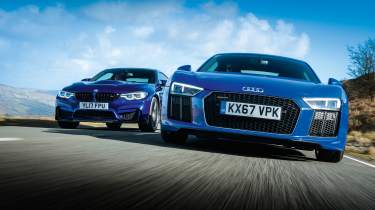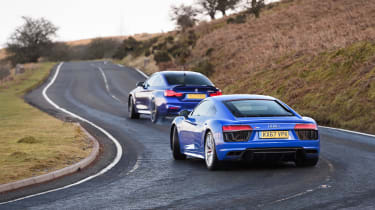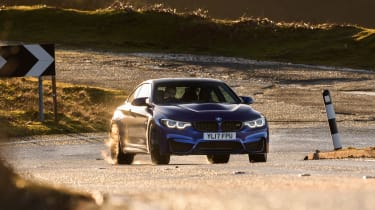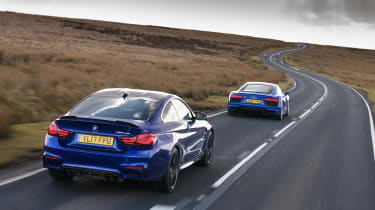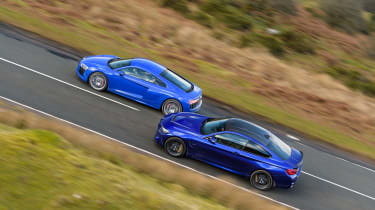Audi R8 RWS vs BMW M4 CS - Audi's mould-breaking supercar takes on BMW's driving hero
How will Audi's first rear-drive R8 stack up against the mighty BMW M4 CS?
Audi R8 versus BMW M4 – surely we can’t be serious? One’s a low-slung, mid-engined entry-level supercar, the other a relatively sensible-looking four-seater coupe, poles apart in concept and execution. On the face of it, yes, but these are a pretty special pair, with one specific quality in common: the R8 V10 RWS (that’s Real Wheel Series, a moniker that will make more sense shortly) and M4 CS are driver’s cars, pure and simple.
At least that’s what their makers say. According to Audi, the RWS is ‘for purists with an appreciation for essential driving enjoyment’, while BMW reckons the CS is ‘the perfect combination for track and everyday use’. Two wildly divergent approaches maybe, but a shared and truly focused goal.
> Click here for our Supertest between the BMW M4, Audi RS5 and AMG C63 Coupe
To find out whether the reality matches the hyperbole, we’ve made a beeline for Wales. It’s cold when we arrive and the tarmac is still glistening from last night’s rain, but the sun is shining and the roads are some of the best in the business, so we’ll soon get under the skin of these dedicated driving machines.
So what makes the RWS so special? Essentially, Audi has broken with a near 40-year tradition and made a go-faster model that’s not four-wheel drive. In fact, for the first time since the 1930s, here is an Audi that’s rear-wheel drive. It’s lighter than a standard R8, too, the deletion of driveshafts and differentials shaving 50kg off the weight of the V10 model. Its chassis has been tweaked to compensate for the reduction and subtle relocation of masses, with different spring and damper rates for the suspension, a stiffer front anti-roll bar and a subtle remap for the electrically assisted steering. Oh, and Audi will be building just 999 of them.
More reviews
Group tests
In-depth reviews
Reviews
- Audi R8 Spyder (2016 - 2024) review – that V10 in surround sound
- Audi R8 V10 RWD and R8 RWD Performance (2020 - 2024) review – Audi's 911 GT3 fighters
- Audi R8 V10 GT RWD (2022 - 2024) review – the R8 bows out in spectacular style
- Audi R8 4.2 FSI V8 quattro (2007 - 2015): review, history and specs of an icon
If anything, the M4 is the more extreme machine. Its twin-turbocharged 3-litre straight-six can’t match the Audi’s thundering 533bhp naturally aspirated V10 for firepower, but with 454bhp it’s 10bhp up on the M4 Competition Package. Crucially, it’s got more torque than the R8, with a monstrous 442lb ft from 4000rpm, compared with the Audi’s 398lb ft at a heady 6500rpm. With no transmission parts to ditch, BMW’s M Division has been forced to work harder to shed weight, which is why carbonfibre is used for the bonnet and the interior has been stripped of unnecessary fripperies. According to our scales the CS weighs in at 1610kg, which is 30kg less than the RWS and 35kg under an M4 Comp Pack. Like the Audi, a seven-speed twin-clutch is the only gearbox option (so much for pure driving thrills, eh?).
> Click here for our review of the Audi R8 V10 Plus
Parked up next to the R8 the normally muscular BMW looks tall and narrow, but it’s packed with details, such as the huge vent in the leading edge of the bonnet, those lovely 19-inch alloy wheels (wrapped in Michelin Pilot Sport Cup 2s) and the discreet carbonfibre flap on the trailing edge of the bootlid. It’s just as special inside, where Alcantara covers the steering wheel, pared-back transmission tunnel and dashboard, while the lightweight door panels feature looped fabric pulls.
By contrast, the Audi looks and feels a little ordinary. I know the R8 still looks stunning and boasts a gorgeously executed cabin; it’s just that the RWS doesn’t offer any clues that it’s something special. Externally there’s some gloss black trim, while inside there’s a plaque on the dash that declares this car to be ‘1 of 999’, but in all other respects it’s just another R8.
Still, any thoughts of ‘ordinary’ are shattered the moment that V10 stirs into life. The way it delivers its power is addictive, the acceleration building proportionally with every fraction of an inch of throttle travel, the ten cylinders delivering an internal combustion orchestra like few others. Above 4000rpm the 5.2-litre really gets into its stride, accelerating with real ferocity, and emitting a spine-tingling howl that has you chasing the 8500rpm red line time and again.
What’s most surprising is the traction, even in the wet. The combination of a rearward weight bias, that deliciously precise throttle and relatively sensible Pirelli P Zeros allows the RWS to dig in and accelerate without hesitation. Audi’s figures suggest the lack of a driven front axle makes the RWS slower off the line, its 0-62mph time of 3.7sec putting it two tenths behind the quattro version, but once rolling there’s barely anything between them. Helping here is the seven-speed S-tronic transmission that serves up shifts so fast and seamless there’s no destabilising forces as the next ratio slips home, and a ride that’s surprisingly compliant, even on passive dampers. Brutal throttle applications betray the rear-driven layout, but only via the briefest flicker of the stability control warning light.
The difference with the CS couldn’t be starker – and not just because it feels like you’re stepping into an SUV after the limbo-low R8. Squeeze the throttle in these greasy conditions and the M4 veers between unsettling and terrifying. Without the necessary temperature in their treads, the Michelins struggle to contain the demonic forces bursting from the blown six-pot. Even with the stability control enabled the BMW struggles – with everything switched off you’ll need to have eaten all your Weetabix, because wheelspin is as likely in fifth gear at 70mph as it is in first at 7mph. Yet as the roads dry out and the tyres warm through, we see the CS’s true potential. With decent purchase on the tarmac the M4 accelerates with vicious intent. Official figures say the CS is two tenths behind the RWS to 62mph, but in the real world there really is nothing to separate them.
What the M4 really lacks is the Audi’s symphonic accompaniment. BMW has deleted the electronic engine augmentation for the CS, giving the 3-litre a more natural voice. Yet while there’s a deep, bassy idle and a crackling bellow as you push it harder, in this company it’s more pub singer than Pavarotti.
Press on in the BMW and at first it all feels very familiar from the standard M4, with the same meaty steering that gives a sense of instant connection with the tarmac, plus the same slightly stiff-legged ride. There’s also still a bewildering array of steering, gearbox and engine maps to choose from, but after some mixing and matching I settle on the softest dampers, the lightest steering, Sport for the engine and stability control, and the least brutal gearshift strategy – the quicker shifts are too harsh and liable to upset the already edgy M4.
There’s terrific bite from the front axle, allowing you to place the car with almost laser-guided precision. Turn-in is so quick that when the tyres are cold and the stability control snoozing you’ll get a surprising amount of oversteer into the corner, which turns into an even bigger slide wide on the exit. The near-perfect balance makes it fairly straightforward to gather up, but this wayward behaviour makes it difficult to take a committed approach. However, as the ambient temperatures rise, the BMW and I click. The CS starts to dig in, delivering strong grip and impressive traction; now I can make use of its shattering pace. With this newfound trust comes the ability to exploit the balance and torque to steer the CS on the throttle, and on one particular S-bend it all comes together, the BMW dancing this way and that, just over the edge of grip but totally in control. It’s a reminder that, given the right road and the right temperatures, the CS can lift its game above the already covetable M4 Competition Package.
It takes a little time to adapt to the R8 after a spell in the M4, not least because it feels so low and wide. Yet the Audi soon reminds you why it is one of the most user-friendly mid-engined machines out there. It just feels so polished and effortless, but not in a remote and detached way. The steering isn’t as hefty as the BMW’s, but it’s quick and offers decent feel, allowing you to instinctively judge the amount of grip. Unlike the M4, the R8 feels stable on turn-in, with the merest hint of stabilising understeer. This can build frustratingly if you’re early on the throttle, but allow the Audi to settle, feed in the power, and the car gently transitions to a neutral stance, helping straighten it for a slingshot exit. It’s efficient and fast, yet engaging at the same time. This feeling of well-honed poise is enhanced by the impressive body control, the long and wide Audi shrugging off bigger bumps that knock the taller and more stiffly suspended BMW fractionally off line.
It’s a hugely impressive display, but also a familiar one, because at the moment the RWS feels just like the quattro R8. Maybe we’re not trying hard enough. I attack the same stretch of road again, with the stability control disabled and with extra commitment. It’s just as composed as before, until we reach a well-sighted, uphill hairpin. Brake hard, hook second gear and turn in. Initially the RWS feels stable and locked on its line, so with the chassis loaded up I get greedy with the throttle – and it’s then that the tail suddenly swings wide, the combination of power and that pendulum of an engine doing their best to rotate the car in its own length. The quick steering helps get things back on track, but quite a lot of space is needed to gather it all up. That might be OK on track, but on the road in a car this big, it’s a sobering moment, and perhaps a glimpse that, like a coupe that’s been chopped into a convertible late in its model cycle, the R8 was never intended to be anything other than four-wheel drive. In fairness, it’s the only time the R8 really misbehaves, but there’s always the feeling it’s just a small overstep away from doing it again, and that it won’t telegraph the transition loudly enough to avoid disaster.
It’s a timely reminder that neither of these machines is perfect. More importantly, neither really delivers on its promise of being the ultimate driver’s car. The M4 CS’s peaks are slightly higher than those of the standard Competition Package, but it needs all the stars to be aligned for it to hit those heights. It’s a beguiling device, but unless you’re planning on spending lots of time on track then the more useable Competition Package delivers 99 per cent of the thrills for £27,630 less.
Despite its flaws, the RWS still feels more extraordinary and memorable. Whereas the BMW is beset by the compromises of what is essentially a four-seater saloon trying to play sports car, the Audi feels like the real deal. It’s also blessed with one of the best engines in the business. Frankly, it could be shackled to a chassis with two left feet and you’d still forgive it the moment you first hear its sonorous cry and feel its explosive energy. Fortunately the R8 has real ability, albeit the sort that’s been smothered in a sheen of ‘Audi‑ness’ that aims to make it as easy to live with as an A3, but which also keeps you from fully connecting with the machine beneath. And this is ultimately the undoing of the RWS, because for most of the time it feels just like the standard R8. Only in extremis is there a difference, and in those situations you’ll crave the quattro’s more cultured manners. It’s a fine machine, the R8 V10 RWS, but not a true driver’s car. For that, you’ll need to look elsewhere…
